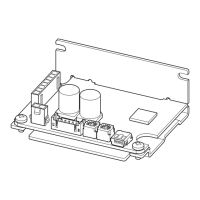138
Alarms
16.2 Alarm history
Up to 10 generated alarms are saved in the non-volatile memory in order of the latest to oldest.
Exceeding 10 alarm records will overwrite the data in order from the oldest recorded data.
Alarm history is not cleared even if the power is shut o.
Alarm history stored in the non-volatile memory can be read and cleared when any of the following items is performed.
•
Read and clear the alarm history using the
MEXE02
.
•
Read the alarm history with the monitor command of RS-485 communication.
•
Clear the alarm history with the maintenance command of RS-485 communication.
The driver status when an alarm was generated is also stored in the alarm history. Items to be stored are shown in the
table below.
Item Description
Code (Hex) This is a code to represent the content of the generated alarm.
Driver temperature This is the driver temperature when an alarm was generated.
Inverter voltage This is the internal voltage of the driver when an alarm was generated.
Selection Number This is the operation data number selected when an alarm was generated.
Load factor This is the load factor when an alarm was generated.
Command Speed This is the command speed when an alarm was generated.
Feedback speed This is the feedback speed when an alarm was generated.
Elapsed time from BOOT This is the elapsed time until an alarm was generated from when the power was turned on.
Elapsed time from Motor
move
This is the elapsed time until an alarm was generated from the start of operation.
Main power supply time
This is the cumulative elapsed time until an alarm was generated from when the main power supply
was rst time turned on.
Direct input
*
This is the input status of the direct inputs (D-IN0 to D-IN4) when an alarm was generated. It is indicated
in hexadecimal.
Remote input
*
This is the input status of the remote inputs (R-IN0 to R-IN15) when an alarm was generated. It is
indicated in hexadecimal.
Internal I/O
*
This is the internal status of I/O signals when an alarm was generated. It is indicated in hexadecimal.
Sub code This is our code for checking.
*
Refer to the tables below for bit arrangements.
When the Initial sensor error and the EEPROM error shortly after power-on are generated, "0" is shown in all elds.
(Except for code, alarm message, main power supply time, internal I/O, and sub code)
Note
Clearing the alarm history cannot be executed in a state where the HMI input is OFF (non-active state).
z
Direct input
bit 7 bit 6 bit 5 bit 4 bit 3 bit 2 bit 1 bit 0
– – –
D-IN4
[ALM-RST]
D-IN3
[M0]
D-IN2
[FWD/REV]
D-IN1
[RUN/BRAKE]
D-IN0
[START/STOP]
z
Remote input
bit 15 bit 14 bit 13 bit 12 bit 11 bit 10 bit 9 bit 8
R-IN15
[Not used]
R-IN14
[Not used]
R-IN13
[Not used]
R-IN12
[Not used]
R-IN11
[Not used]
R-IN10
[Not used]
R-IN9
[Not used]
R-IN8
[Not used]
bit 7 bit 6 bit 5 bit 4 bit 3 bit 2 bit 1 bit 0
R-IN7
[ALM-RST]
R-IN6
[Not used]
R-IN5
[FWD/REV]
R-IN4
[RUN/BRAKE]
R-IN3
[START/STOP]
R-IN2
[M2]
R-IN1
[M1]
R-IN0
[M0]
Values in brackets [ ] are initial values.
z
Internal I/O
bit 15 bit 14 bit 13 bit 12 bit 11 bit 10 bit 9 bit 8
– – – TL HMI
STOP-MODE
(FWD/REV)
REV
(RUN/BRAKE)
FWD
(START/STOP)
bit 7 bit 6 bit 5 bit 4 bit 3 bit 2 bit 1 bit 0
– – SYS-BSY VA MOVE DIR TLC SPEED-OUT

